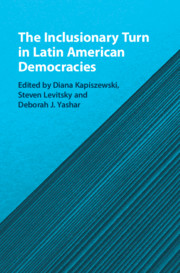Book contents
- The Inclusionary Turn in Latin American Democracies
- The Inclusionary Turn in Latin American Democracies
- Copyright page
- Contents
- Figures
- Tables
- Contributors
- Acknowledgments
- Prologue: Reflections on Two Episodes of Popular Inclusion
- 1 Inequality, Democracy, and the Inclusionary Turn in Latin America
- Part I Extending Social Policy and Participation
- Part II Inclusion and Partisan Representation
- 6 Changing Patterns of Ideology and Partisanship in Latin America
- 7 Brokering Inclusion
- 8 States of Discontent
- Part III New Party–Society Linkages
- Part IV Inclusion, Populism, and Democracy
- References
8 - States of Discontent
State Crises, Party System Change, and Inclusion in South America
from Part II - Inclusion and Partisan Representation
Published online by Cambridge University Press: 12 January 2021
- The Inclusionary Turn in Latin American Democracies
- The Inclusionary Turn in Latin American Democracies
- Copyright page
- Contents
- Figures
- Tables
- Contributors
- Acknowledgments
- Prologue: Reflections on Two Episodes of Popular Inclusion
- 1 Inequality, Democracy, and the Inclusionary Turn in Latin America
- Part I Extending Social Policy and Participation
- Part II Inclusion and Partisan Representation
- 6 Changing Patterns of Ideology and Partisanship in Latin America
- 7 Brokering Inclusion
- 8 States of Discontent
- Part III New Party–Society Linkages
- Part IV Inclusion, Populism, and Democracy
- References
Summary
Latin America’s recent inclusionary turn centers on changing relationships between the popular sectors and the state. Yet the new inclusion unfolds in a region in which most states are weak and prone to severe pathologies, such as corruption, inefficiency, and particularism. The first part of the chapter outlines an argument, developed at more length elsewhere, regarding how “state crises” helped drive the consolidation of three distinct party system trajectories among the eight South American countries where the Left would eventually win power. The second part of the chapter argues that these trajectories differed in three ways that likely conditioned how the concomitant inclusionary Left turn unfolded in each case: the institutionalization of left-wing parties, the occurrence of state transformation via constitutional reform, and the level of state capacity. The discussion helps highlight the central role of the state and its pathologies in both driving alternative paths of political development and in conditioning the politics of inclusion. By putting the emphasis on the state and its pathologies, we can better consider not just the sources of sociopolitical exclusion but also the limits of sociopolitical inclusion.
- Type
- Chapter
- Information
- The Inclusionary Turn in Latin American Democracies , pp. 254 - 284Publisher: Cambridge University PressPrint publication year: 2021
References
- 1
- Cited by

